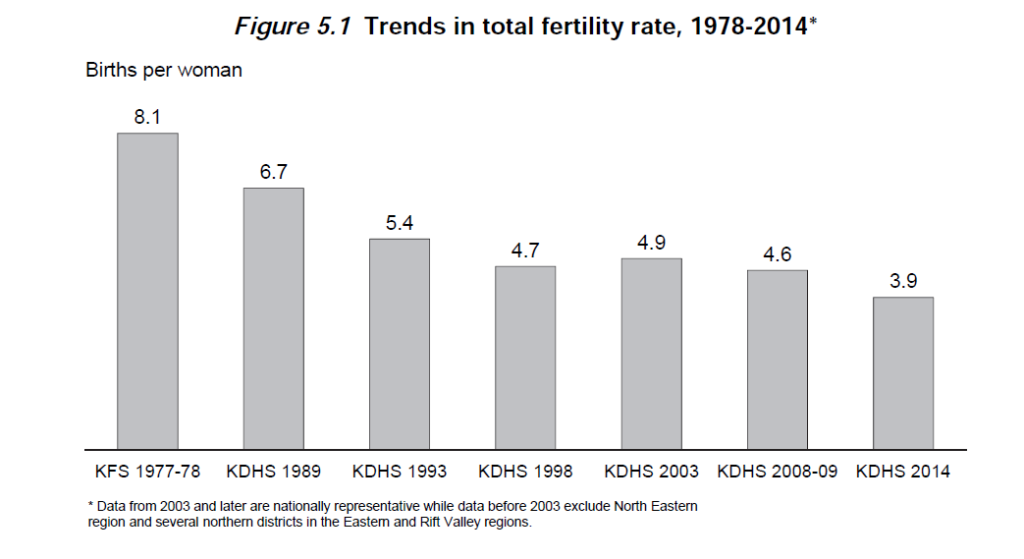
Fertility
Emmanuel Macron recently suggested that African women are giving birth to 7-8 children. A rant that mentioned civilisation and ‘such-a-like’ nonsense…..
But are we African women really breeding like rabbits?
The only truth in what Macron said is that Africa does have a high fertility rate when compared to other continents. But what are the real figures on fertility – I will focus on Kenya – which conducts a comprehensive health and demographic survey – the last one conducted in 2014 – the report is free to download……
Kenya’s Demographic Health Survey – 2014
According to this survey – Kenya has a total fertility rate (TFR) of 3.9.
Let’s define Total fertility Rate (TFR): In very crude and simple terms, it is the total number of children that a woman from a particular population will have during her life (** little note on TFR in the footnotes).
Therefore on average, Kenyan women are having a total of 4 children in their lifetime.
In Kenya fertility is driven by education and wealth.
Women with no education at all have a TFR of 6.5, those with some education 4.8, those with secondary education and higher, the TFR was 3.
The survey shows that the wealthiest regions have the lowest fertility – In Kirinyaga TFR is 2.3 and in Nyeri, Kiambu and Nairobi, its 2.7. The poorest, most marginalised regions have the highest fertility: Wajir and West Pokot have a TFR over 7. The region with the highest fertility in Kenya is North -Eastern. Not surprisingly this is the region with highest insecurity, poorest child survival, least educated women and highest teenage pregnancy rates.
Kenya’s economy has improved over the years and education completion for girls is rising. The fertility rates have been declining steadily and are bound to continue to go down as marginalised regions improve…
The last time Kenya had an average fertility rate of 7 was in the 1970’s and since then, the decline is steady.
Once a community has enough food and medicine for its children, when girls complete secondary school and child survival is high – the community begins to accept women having fewer children. The small number of children had will have a better life than their parents and will themselves have less children. There is less pressure from everyone to breed.
USAID 2013, health and demographic survey and discusses all the factors leading to a reduction in TFR in Sub-Saharan Africa and childhood survival is a strong factor in the reduction of TFR…..
Factors contributing to Africa’s decreasing fertility – USAID-2013 report
There is also the lack of awareness and availability of contraception. Bill and Melinda are pouring money into contraception availability in Africa – which is great…..
Melinda Gates on contraception funding
However, when the West openly pours money into birth control in Africa – it can easily misfire especially when rhetoric from donor countries feeds into underlying fears – sentiments that express the need to control the population of others…..
http://www.bbc.co.uk/news/world-europe-40588246
European fear of African fertility is balanced by Africa’s suspicion of what is going to be done to their bodies. Vigorously pushed health interventions supported by the West and carried out on the African continent has been linked with sterility rumours over the years…..
Health interventions and the persistence of rumour
Making contraceptives available should never be linked with efforts to control the numbers of a particular group of people but about the rights of a woman to determine how many children she wants. A very healthy outlook on contraception in Africa was provided by Melinda Gates in a Ted Talk….
Melinda puts the point across extremely well – its access to contraception that is important not the need to control other people.
On top of all these is the fact that there is a lot of myth and folklore about contraceptives on the continent – check this newspaper article….
30 years on myths and misconceptions still a barrier to contraceptive use
Plenty of health education is needed – done properly, without a rush. However, in the end, aid and rumours not withstanding – if women are educated and have enough to eat – fertility will reduce.
****************************************
**Little note on TFR
TFR is calculated using data from women of child bearing age over a period of time in a population. Categorised by age, the number of live births as a proportion of women in that age group is calculated. All the proportions from the different age groups are added up. This is referred to as the Total Fertility Rate (TFR). The rate can yield weird numbers like 2.1 or 3.9. This looks strange as there is no 0.1th of a child – but that is how the number is calculated.
Comments
Comments are closed.







Sam H
I loved this. A sensible view on how to progress women’s choices about breeding and then allowing children a better quality of life. Thanks Tabs.